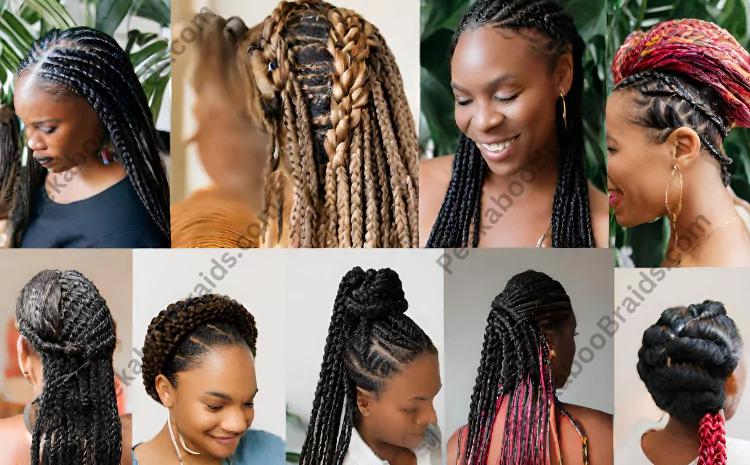African braids and braiding techniques create beautiful, artistic hairstyles that celebrate African culture and identity. Braided hairstyles are an important part of African traditions, values, and aesthetic beauty. This comprehensive guide covers everything you need to know about African braids.
Key Takeaways
- African braiding techniques like cornrows, box braids, and Senegalese twists create stunning protective styles.
- Braided hairstyles originated in African cultures and have deep cultural significance.
- Braiding helps hair grow longer and stronger by minimizing breakage.
- Finding an experienced braider at an African braiding salon is recommended for beginners.
- Maintaining braids requires gentle shampooing, moisturizing, and twisting the new growth.
- Take down braids carefully and deep condition to restore moisture.
Overview of African Braiding Techniques
There are endless creative ways to braid African hair. Here are some of the most popular techniques:
- Cornrows – Braids lie close to the scalp in straight rows. Versatile classic style.
- Box braids – Square parts make boxy braids with textured ends. Long lasting.
- Senegalese twists – Twisted braids with curly ends create a rope-like look. Stunning and chic.
- Tree braids – Braids flow out from one central part like tree branches. Artistic statement hairstyle.
- Faux locs – Use synthetic hair to imitate the look of locs. Fun style without commitment.
- Braidlocs – Tiny braids create the look of thin locs. Lightweight and easy to maintain.
- Feed in braids – Small braids feed into a larger braid. Great protective style.
- Ghana braiding – Intricately layered and cornrowed style from Ghana. Striking and ornate.
| Braiding Technique | Description |
|---|---|
| Cornrows | Straight braids lying flat against the scalp in rows |
| Box Braids | Boxy, square parted braids with textured ends |
| Senegalese Twists | Twisted ropes with curly ends |
| Tree Braids | Braids radiating from one center part |
The Rich Cultural History of African Braiding
In many African cultures, braided hairstyles are an important part of social traditions, rituals, and expressing identity. Braiding patterns and styles can indicate a person’s marital status, age, religion, ethnic identity, wealth, and rank within the community.
Elaborate braided hairstyles are created for important ceremonies like weddings and coming-of-age rituals. Braiding is a communal tradition, with people coming together to braid each other’s hair. The time spent braiding is filled with conversation, storytelling, and sharing wisdom.
When enslaved Africans were taken to the Americas, they preserved braiding traditions as much as possible. Braiding helped maintain cultural ties and pass down values. Today, African braids techniques continue to celebrate black identity and empowerment.
The Benefits of Braided Hairstyles
Braiding has many benefits beyond just looking fab:
Protect hair from damage – Keeping hair in braids protects it from daily styling damage caused by brushing, heat tools, and environmental exposure. Less manipulation allows hair to grow longer and stronger.
Low maintenance – Braids only need to be redone every few weeks. They make styling easy in between salon visits.
Relieve traction alopecia – Braids minimize tension on the hairline compared to styles like weaves. This helps prevent breakage and hair loss.
Retain length – Braid ends are safely tucked away, preventing dryness and split ends. Hair stays moisturized as it grows out.
Versatility – Braids can be dressed up or down for any occasion. Add jewelry or styling products to customize your look.
How To Get Your Hair Braided Professionally?
For beginners, getting your hair braided by an experienced stylist at an African braiding salon is recommended. Here are some tips for your first braiding appointment:
- Choose the right salon – Look for braiders who are gentle, patient, and listen to your desired look. Read reviews and ask for recommendations.
- Come with clean, tangle-free hair – Shampoo and condition your hair before. Detangle using a pre-poo treatment, wide tooth comb, or fingers.
- Discuss size and style – Smaller braids may feel tighter but last longer. Larger braids are heavier but more comfortable for first timers.
- Plan for a long appointment – Sessions can take 6-10 hours depending on hair length and number of braids. Come prepared with snacks and entertainment!
- Prepare for some discomfort – Especially near the hairline, tightness and pulling may cause mild pain as the hair adjusts.
- Carefully shampoo and moisturize – Follow your stylist’s instructions for washing and moisturizing new braids. Avoid disturbing the roots.
Caring for Braids at Home
To help your braids last 4-6 weeks or longer, proper at-home care is essential:
- Gently shampoo scalp – Use a silicone-free, sulfate-free shampoo to cleanse scalp buildup. Avoid braid bases.
- Moisturize hair and scalp – Spray braids lightly with water, then seal in moisture with an oil or butter. Massage scalp.
- Twist new growth – As hair grows out, twist the roots to maintain a neat look and prevent unraveling.
- Protect edges – Tie hair back at night with a silk scarf. Brush edges gently.
- See a stylist promptly – Schedule a tightening or redo as soon as excessive frizziness or looseness occurs.
How To Safely Take Down and Maintain Braids?
When it’s time to take out your braids, be patient and gentle to keep hair healthy:
- Set aside ample time – Rushing can cause breakage. Make sure you have a few hours.
- Saturate with oil – Coat the entire length of braids with oil and let it soak in to minimize tangles.
- Remove beads/jewelry carefully – Unhook latches or threads slowly. If stuck, pour oil on the ornament and wait.
- Unbraid strand by strand – Gently unravel each plait starting from the ends. Use detangler brush or wide tooth comb.
- Trim ends if needed – Inspect for split or damaged ends and trim 1/4 to 1/2 inch.
- Deep condition treatment – Nourish and restore moisture with a hair mask.
- Protective style – Avoid heat styling. Put hair in twists or braids while it recovers.
Proper home care extends the life of braids, while taking them down with care ensures your natural hair stays healthy and minimizes shedding.
African Braiding Glossary
Here are some common terms used in African braiding:
- Underbraiding – Braiding the hair underneath, close to the scalp before adding extensions. Provides anchor for long braids.
- Feed-ins – Small braids leading into a larger braid. Allows braiding with natural hair.
- Micro braids – Extremely tiny, thin braids. Lay close to the head and look like cornrows.
- Kanekalon hair – Synthetic fiber used for braiding extensions. Cheaper alternative to human hair.
- Pre-stretching – Pulling kanekalon hair before braiding to reduce frizz.
- Tree braiding – Radial braids originating from one center part. Resemble branches of a tree.
- Locking – Wrapping synthetic hair around braid bases to start dreadlocks.
- Interlocking – Technique for starting sisterlocks by braiding extensions into very tiny braids.

Hi there! I’m M.Afzal, a passionate and experienced hair stylist with a love for creating unique and trendsetting looks. With years of expertise in the industry, I’m dedicated to sharing top-notch advice and inspiring ideas to elevate your hairstyle game. Join me on this journey of beauty and self-expression as we explore the captivating world of peekaboo braids and much more!

